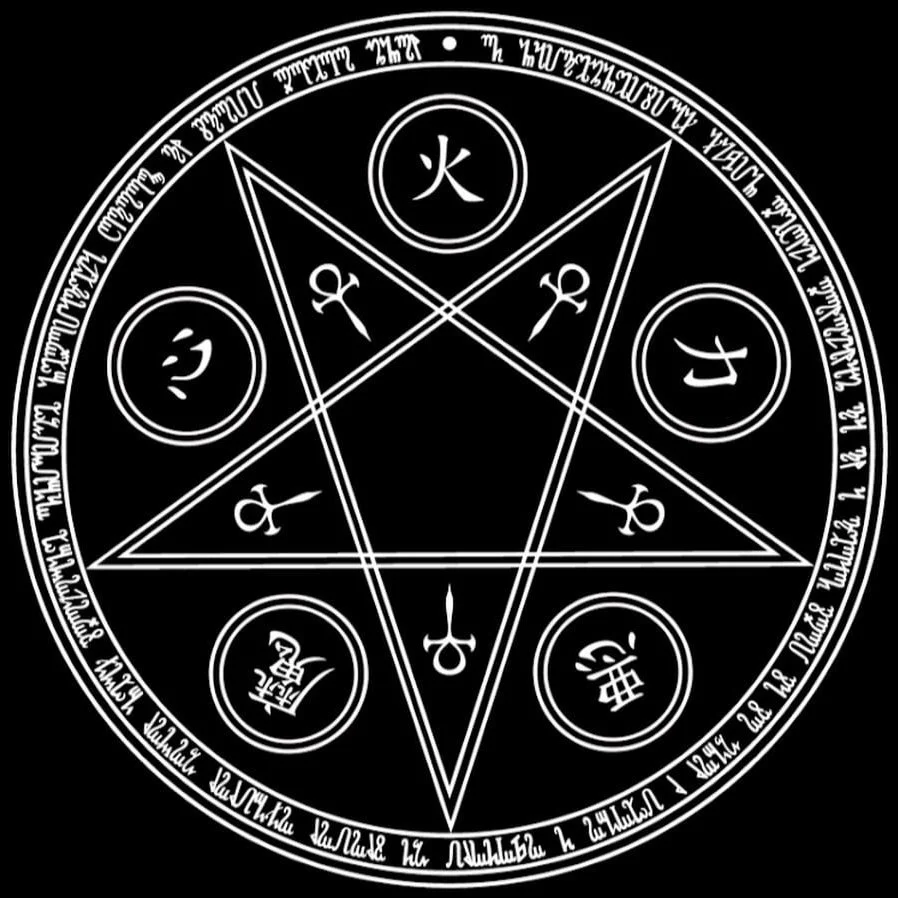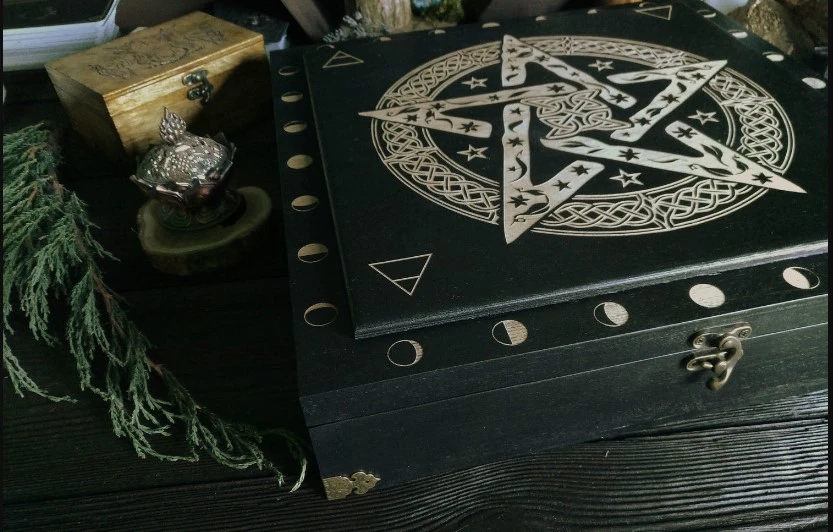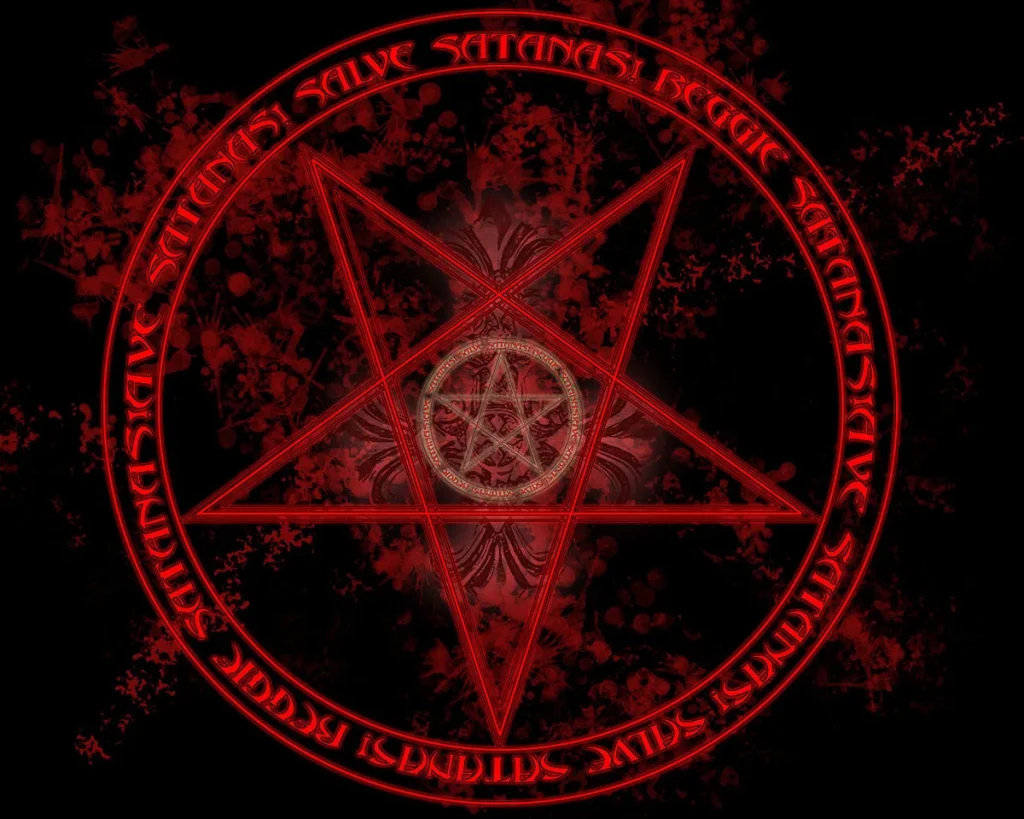The pentacle symbol has a rich and diverse history that spans across various cultures and civilizations. Its origins can be traced back to ancient Mesopotamia, where it was associated with the worship of the five celestial bodies – the sun, moon, Mars, Venus, and Jupiter. Over time, this witch symbol found its way into other belief systems, such as Wicca symbols, Neopaganism, and modern witchcraft, where it holds great significance.
In its most basic form, the pentacle is a five-pointed star enclosed by a circle. Each point represents one of the five elements – earth, air, fire, water, and spirit – and the circle symbolizes the interconnectedness of these elements. This symbolism speaks to the fundamental balance and harmony required in the natural world. The pentacle encompasses not only the physical elements but also the spiritual essence that connects all things. As such, it serves as a potent symbol of unity, creation, and the cyclical nature of life.
Origins and History of the Pentacle Symbol
The origins of the pentacle symbol can be traced back to ancient civilizations, including the Mesopotamians, Egyptians, and Greeks. These cultures regarded the pentacle as a powerful symbol representing various elements and concepts. In Mesopotamia, the pentacle was associated with the goddess Ishtar and symbolized protection and divine connection. The Egyptians, on the other hand, considered the pentacle as a symbol of life and used it in various religious ceremonies and rituals.
In ancient Greece, the pentacle held deep significance as well. It was believed to represent the five elements: earth, air, fire, water, and spirit. These elements were essential aspects of the natural world and played a vital role in Greek mythology and philosophy. The pentacle symbolized the harmonious balance of these elements, emphasizing the interconnectedness of all things. Over time, the pentacle became widely recognized as a symbol of unity, balance, and protection, transcending cultural boundaries and gaining significance in various spiritual practices and belief systems.
The Meaning and Significance of the Pentacle Symbol
The pentacle, a symbol composed of a five-pointed star encircled by a circle, holds deep meaning and significance in various spiritual and mystical practices. At its core, the pentacle represents the union and balance of the elements of earth, air, fire, water, and spirit. Each point of the star corresponds to one of these elements, and the circle encompassing it symbolizes the everlasting interconnectedness of all these energies. This harmonic integration of the elements is a crucial aspect of the pentacle’s meaning, portraying the idea that all forces and energies in the universe are intrinsically linked.
Through its symbolism, the pentacle also serves as a representation of protection. Historically, the pentacle has been used as an amulet or talisman to ward off negative energies and safeguard the wearer from harm. Its five points are believed to act as powerful barriers, deflecting malevolent forces and ensuring the preservation of spiritual purity. The circle surrounding the star acts as a shield, preventing any outside influences from penetrating its sacred space. This protective aspect of the pentacle extends beyond physical protection, encompassing emotional, mental, and spiritual well-being as well.


Exploring the Elements Represented in the Pentacle
The pentacle is a symbol that holds deep meaning and significance in various belief systems and practices. One of the key aspects explored in the pentacle is the four elements: earth, air, fire, and water. These elements are fundamental in many spiritual and magical traditions, representing different aspects of the natural world and the human experience.
Earth, the first element, symbolizes stability, groundedness, and abundance. It is associated with physical manifestations, material wealth, and growth. The earth element in the pentacle reminds us to stay rooted and connected to the physical world, to nurture and sustain ourselves and our environment.
Air, the second element, represents intellect, communication, and knowledge. It is often associated with thoughts, ideas, and the power of the mind. In the pentacle, the air element serves as a reminder to engage in critical thinking, to seek wisdom and understanding, and to communicate effectively and clearly in our interactions.
Fire, the third element, is a symbol of energy, passion, and transformation. It represents the spark of life, motivation, and the ability to take action. Within the pentacle, fire encourages us to embrace our passion, to pursue our desires, and to ignite change in our lives and the world around us.
Water, the fourth element, signifies emotions, intuition, and healing. It is often linked to the unconscious mind, intuition, and the ebb and flow of emotions. In the pentacle, water prompts us to explore our emotional landscape, to tap into our intuition, and to embrace the healing and transformative power of our emotions.
Together, these four elements form a harmonious blend within the pentacle, symbolizing the interconnectedness of all things. Exploring the elements represented in the pentacle provides a framework for understanding our place in the world and how we can align ourselves with the natural forces that surround us. By working with these elements, we can cultivate balance, growth, and spiritual evolution in our lives.
The Pentacle as a Symbol of Protection
The pentacle has long been recognized as a powerful symbol of protection. Worn or displayed, it is believed to create a shield against negative energies and harmful forces. This symbol, with its five-pointed star enclosed within a circle, has been used by various cultures throughout history as a form of spiritual and magical protection.
In Wiccan and Pagan traditions, the pentacle represents the five elements: earth, air, fire, water, and spirit. These elements are believed to make up the fabric of the universe and hold immense power. By invoking the energies of these elements, the pentacle acts as a conduit for spiritual protection. It serves as a reminder to practitioners to stay grounded, balanced, and connected to the natural world. When used in ritual or spellwork, the pentacle can be employed as a tool to ward off negativity, create boundaries, and enhance the overall energetic atmosphere. Its presence is believed to amplify intentions and strengthen the protective energies surrounding the practitioner.
The Role of the Pentacle in Rituals and Spellwork
The Pentacle holds a significant role in rituals and spellwork, serving as a powerful tool for practitioners. When incorporated into rituals, the Pentacle becomes a symbol of protection and a conduit for energy. It is often used to create sacred space and establish a connection to the divine. Through its intricate design, the Pentacle represents the unity of the elements – earth, air, fire, water, and spirit – making it a versatile symbol for various types of spellwork.
In ritualistic practices, the Pentacle is often placed at the center of an altar or used as a focal point. It acts as a gateway for energy to flow, enabling practitioners to harness and direct their intentions. Through the positioning of elemental representations on the Pentacle, such as crystals, herbs, or candles, spellwork can be enhanced with the specific elemental properties desired for the intended results. The Pentacle also provides a solid foundation for energetic protection, grounding the practitioner and creating a sense of stability and balance. Its intricate interwoven lines and circles serve as a visual representation of the connection between the physical and spiritual realms, amplifying the effectiveness of rituals and spellwork.


Different Variations and Depictions of the Pentacle
The Pentacle is a symbol that has been depicted in various ways throughout history. One common variation of the Pentacle is the traditional five-pointed star enclosed within a circle. This version is often associated with Pagan and Wiccan practices, representing the four elements of earth, air, fire, and water, with the fifth point representing spirit or the divine. Another variation of the Pentacle incorporates intricate designs within each of the five points, adding a level of complexity and personalization to the symbol.
In addition to these variations, the Pentacle can also be depicted as a simple outline of the five-pointed star, devoid of any additional embellishments. This minimalist approach highlights the essence of the symbol, allowing for a more abstract interpretation. Furthermore, the Pentacle can be represented in different materials such as wood, metal, or crystal, which can further contribute to the overall symbolism and energy of the symbol. Overall, these different variations and depictions of the Pentacle provide individuals with a wide range of choices to connect with the symbol in a way that resonates deeply with their beliefs and practices.
Misconceptions and Misinterpretations of the Pentacle
One common misconception about the pentacle symbol is that it is synonymous with evil or satanic worship. This misunderstanding stems from the association of the pentacle with the infamous inverted pentagram, which is often used in dark magic or occult practices. However, it is important to note that the pentacle itself is a neutral symbol that can be interpreted in various ways depending on the individual or group using it. It is not inherently good or evil, but rather represents a connection to nature, spirituality, and the elements.
Another misconception is that the pentacle is exclusively associated with Wicca or other pagan religions. While it is indeed an important symbol in these belief systems, it is not limited to them. The pentacle has been used throughout history by different cultures and religions, including ancient civilizations like the Egyptians, Greeks, and Celts. In fact, it is often seen as a universal symbol of protection, representing the five elements (earth, air, fire, water, and spirit) and their harmonious balance. Therefore, it is crucial to understand that the pentacle’s meaning and significance can vary depending on the context and beliefs of the individual or group using it.


Pingback: The Pentacle Symbol: A Symbol of Protection and...